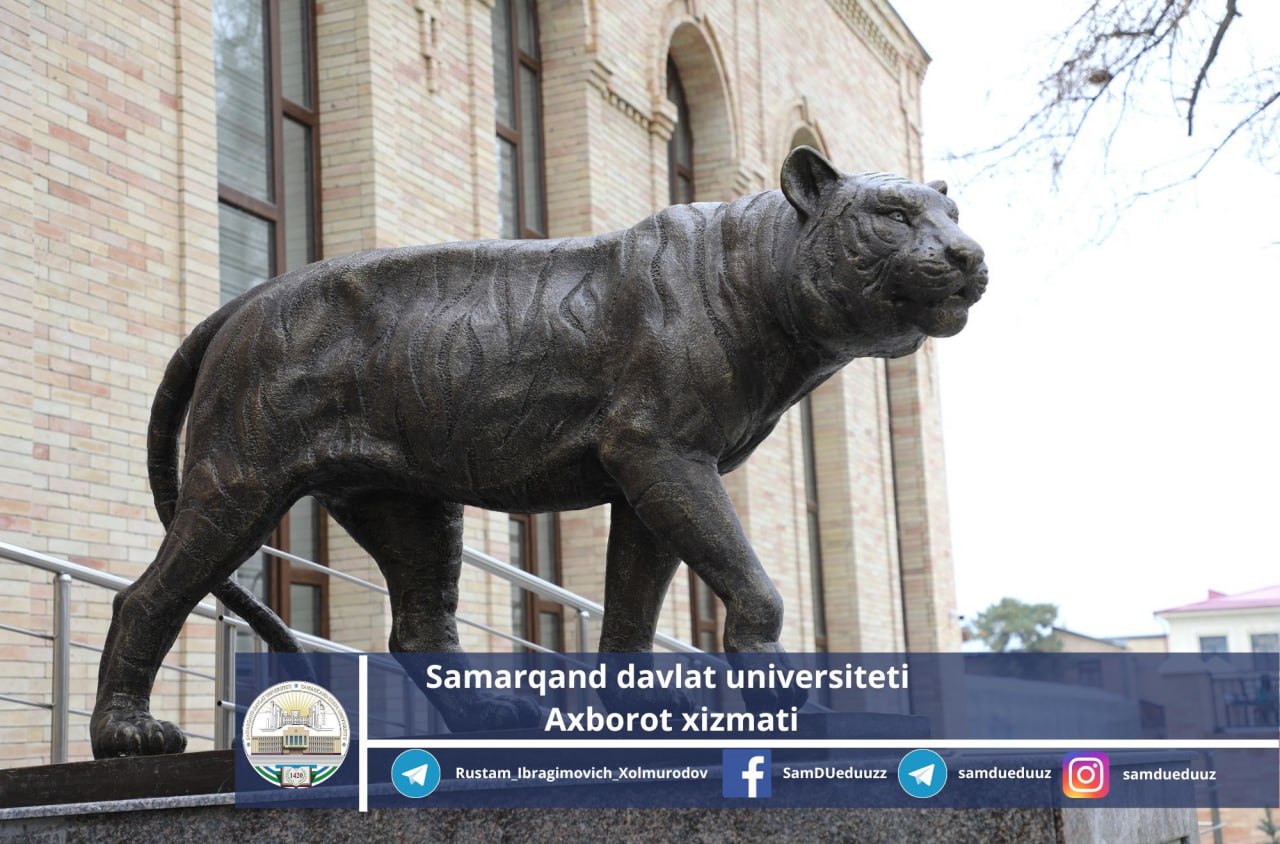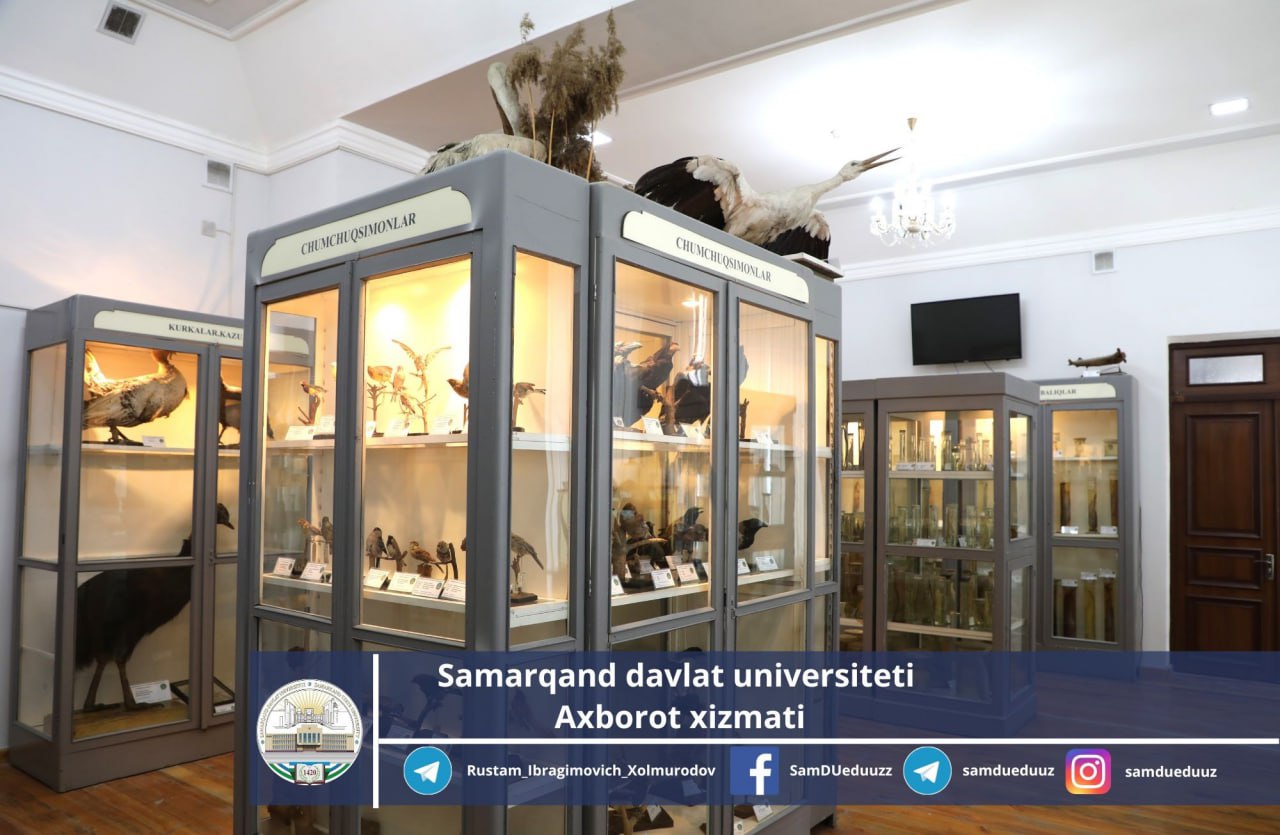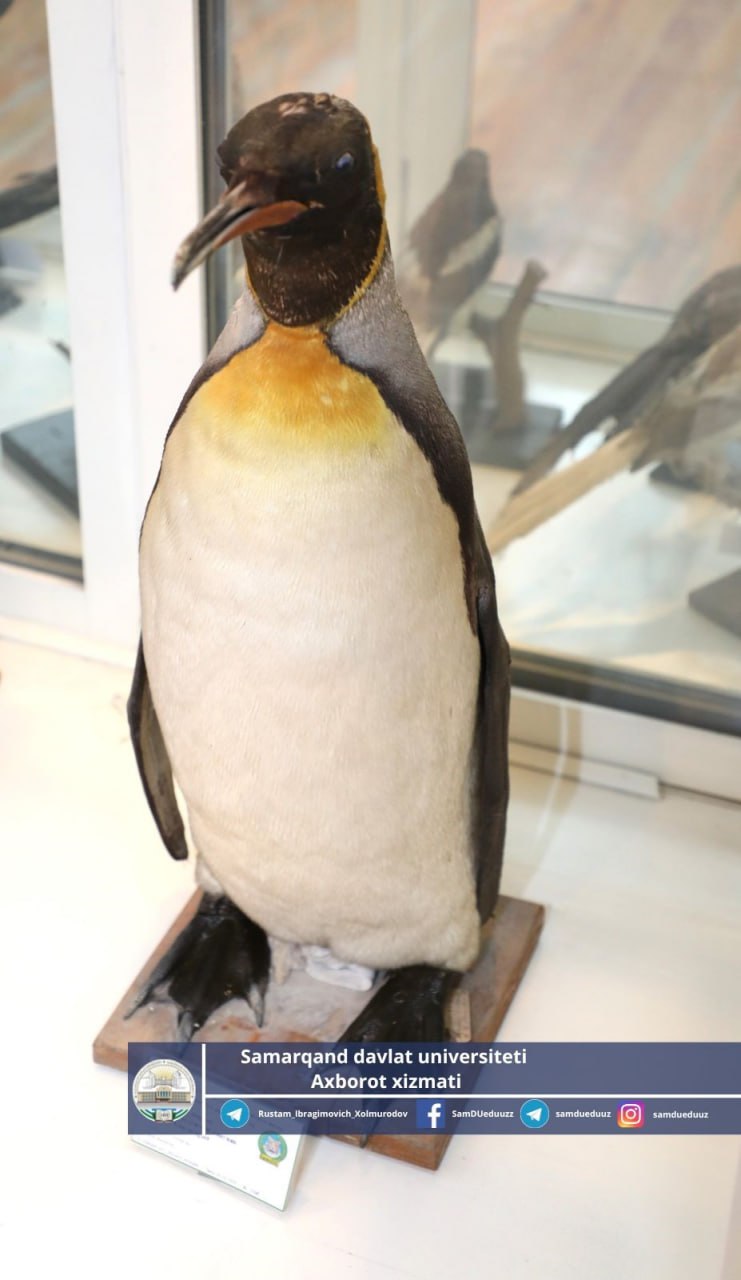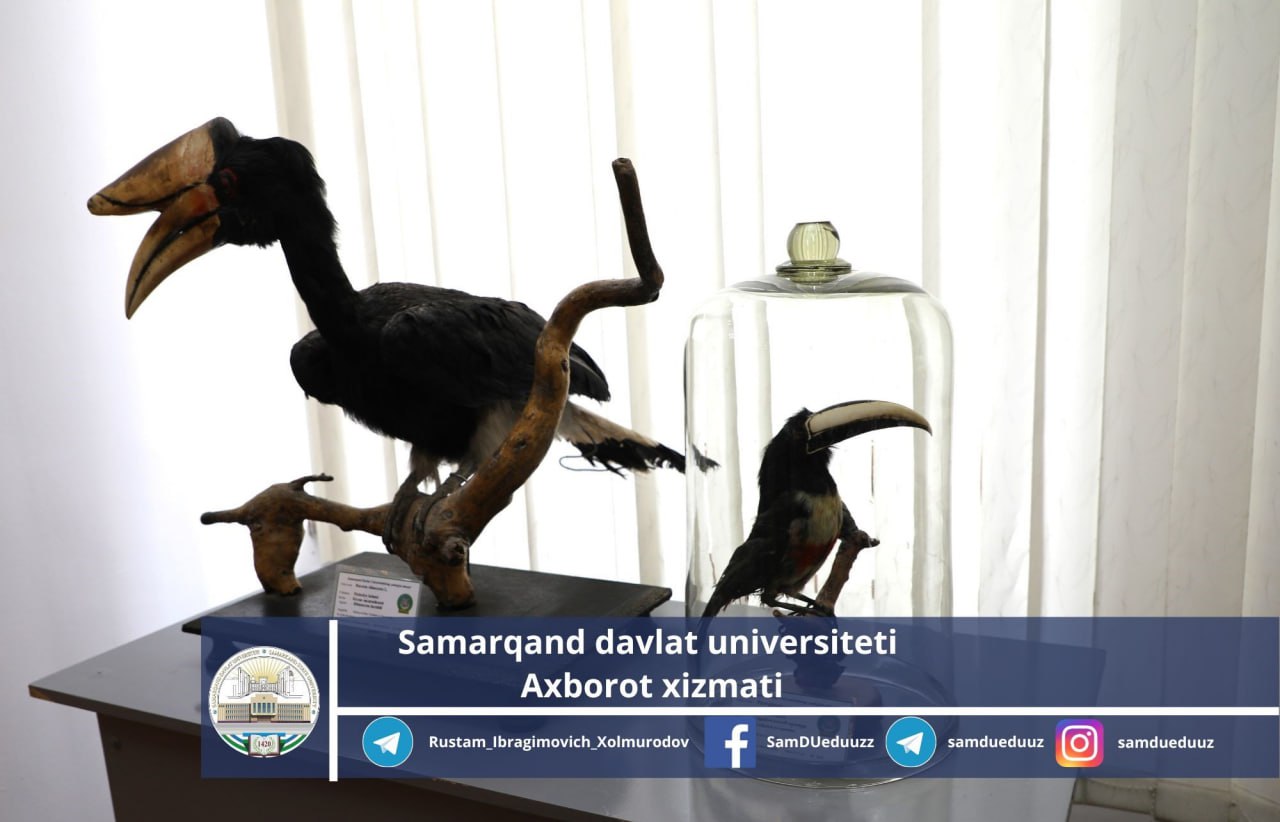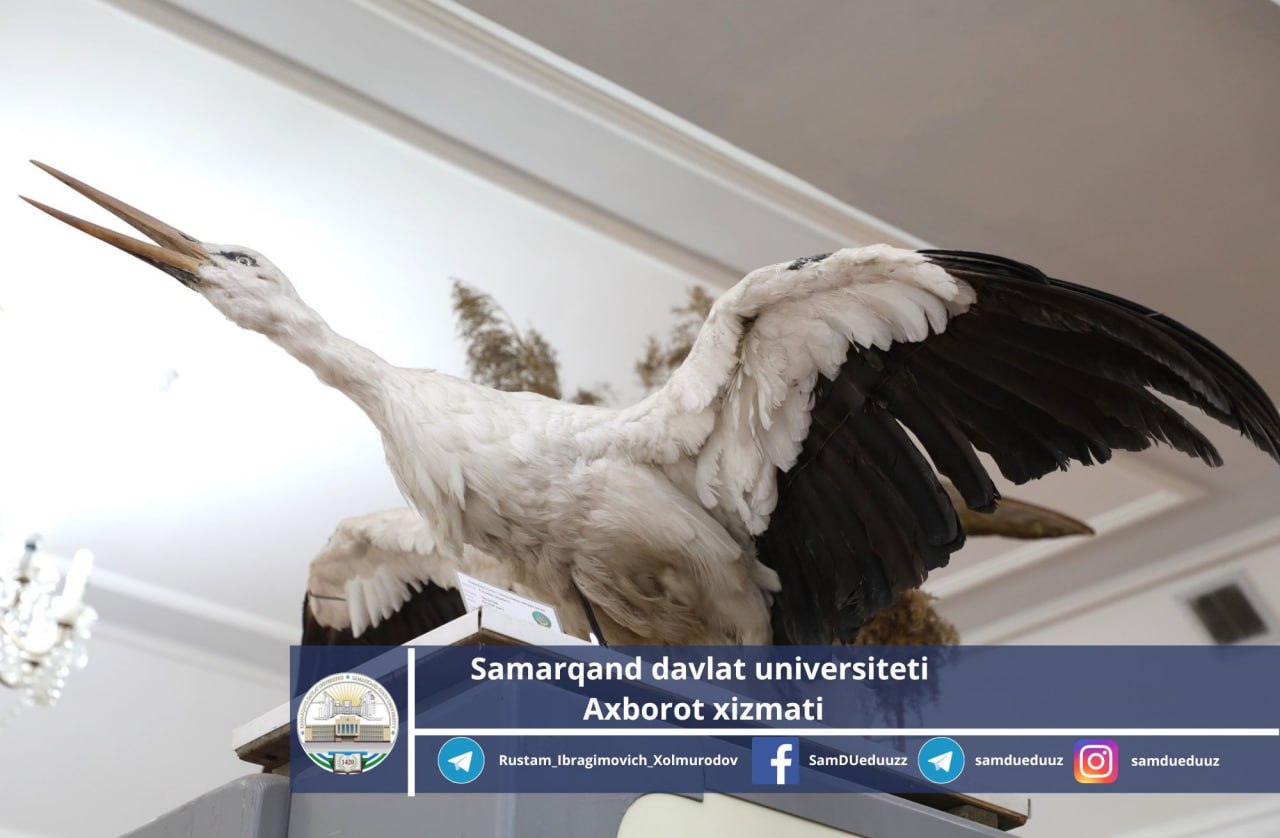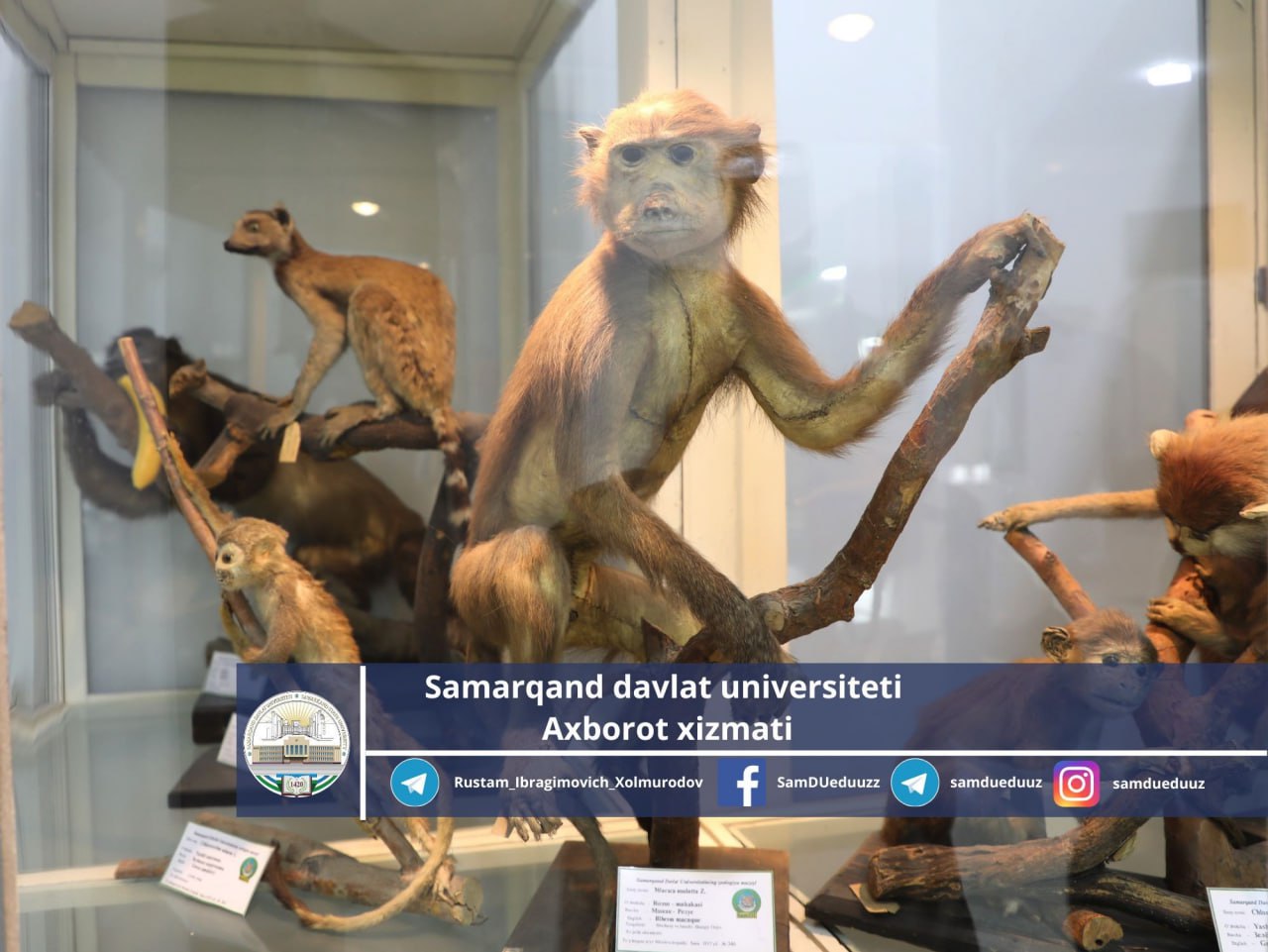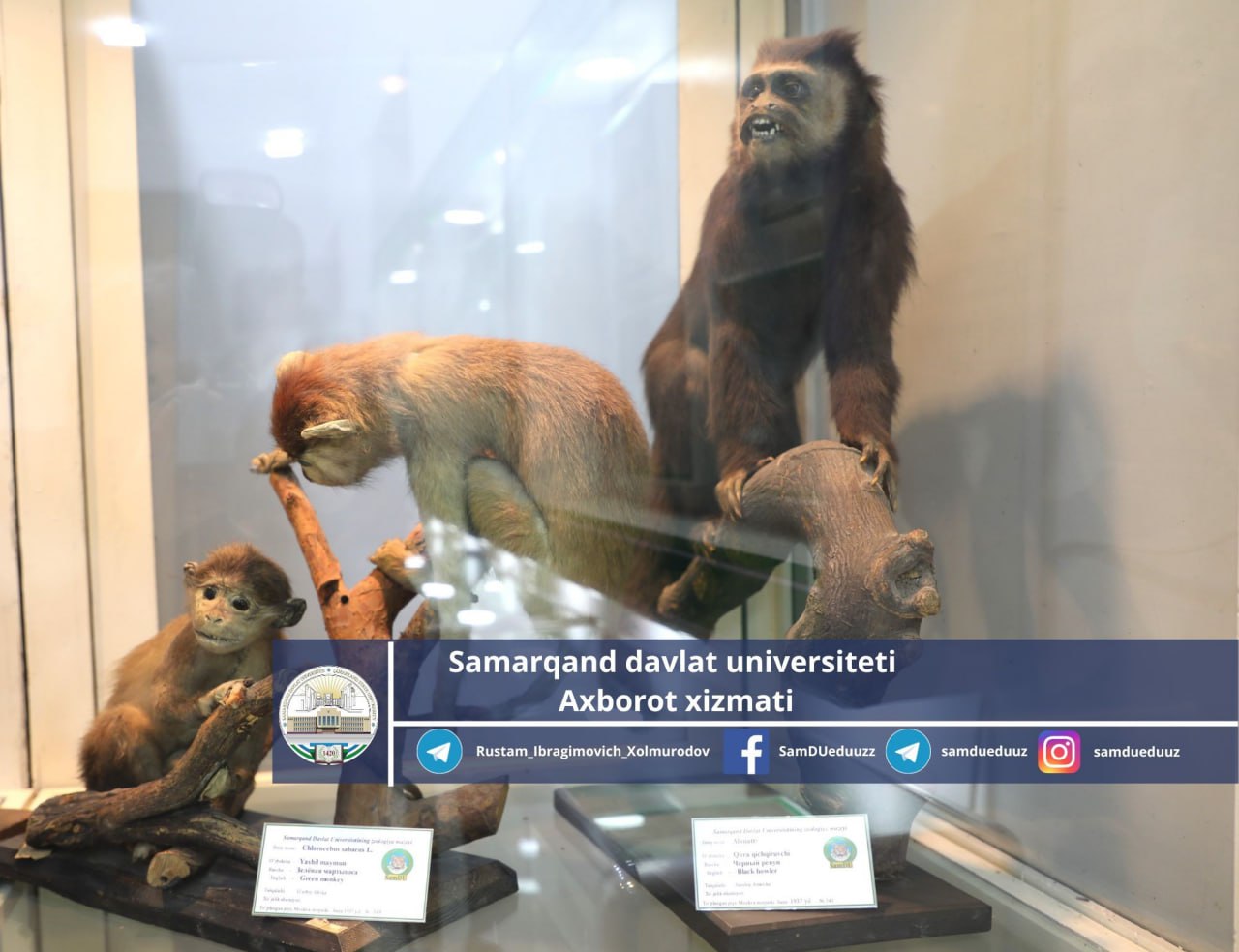Samarkand State University named after Sharof Rashidov Museum of Zoology
The Museum of Zoology of Samarkand State University named after Sharof Rashidov was established in 1934 by the initiative of famous faunists S.K.Dal, K.K.Dal and collector K.K.Povarova. The Museum of Zoology is the only zoological museum in Uzbekistan and Central Asia, which has a collection of more than 6,000 rare and unique animals.
The Zoological Museum is a valuable resource for studying the systematics, faunistics, ecology and phylogeny of invertebrates and vertebrates, determining the species composition of fish found in the middle reaches of the Zarafshan River, conducting ichthyological, ornithological, theriological and anatomical-morphological research in the region. The Museum of Zoology has its place and importance in carrying out scientific and pedagogical activities productively and efficiently, forming the ecological culture and ideology of the next generation as soon as possible, as well as carrying out environmental education and upbringing correctly, and protecting living nature. his role is extremely big.
In addition, the Museum of Zoology has an entomological collection containing 10,000 species of insects, a total of 100-110,000 different insects, and an osteological collection on the history of the theriofauna of Central Asia. Currently, 30-40 percent of the animal species that are exhibits in the museum are almost not found in nature or have become rare, and some have become completely extinct. For example, the exhibit of the Turanian tiger caught from the shores of the Amudarya in 1935 is available only in our museum in the world. It is a very valuable fur animal belonging to the Martes family, whose number is decreasing in recent years - Central Asian or Iranian beaver (Lutra lutra seistanica), included in the Red Book of Uzbekistan and the Red List of the International Union for Conservation of Nature and Natural Resources, the ilvirs or snow bear (Uncia uncia) is a species whose number is decreasing in its area. Another interesting exhibit of the Zoological Museum is the skeleton of an Indian elephant. Among the representatives of the bird fauna, there are rare exhibits of the common tern (Cyanopica cyana) made in 1862, the corolin ordagi (Aix sponsa) made in the last century, the swan (Cygnus olor Gmelin) included in the Red Book of Uzbekistan caught in 1910 from the surroundings of Urgut is a scientific exhibit.
Another uniqueness of the Zoological Museum is that some of the exhibits stored in it are species included in the Red Book of Uzbekistan and the Red List of the International Union for the Protection of Nature and Natural Resources.
This unique object has a valuable osteological collection on the history of the theriofauna of Central Asia, and museum exhibits, especially the museum's osteological collection dedicated to the history of the theriofauna of Central Asia in the anthropogenic period, are extremely important in training highly qualified specialists.
In recent years, more than 1,000 new zoological exhibits, more than 500 entomological collections were prepared in the museum, and the only taxidermy laboratory in the Republic was established under the museum. Students of the department are involved in the work of this laboratory, and 2-3 taxidermists are trained every year. The work of the taxidermy laboratory of students at the museum during the day and night is to prepare taxidermy exhibits in the museum, to repair museum exhibits, to fill them with new exhibits. completion of dissertations shows that the prospect of preparing taxidermist specialists of the Zoological Museum in the future is particularly noteworthy. The zoological exhibits prepared by the students are placed in the museum's showcases and leave a positive impression on the foreign and local guests who visited the museum.
In 2011, zoological museum of SamSU was included in the annotated directory "Музеи университетов Евразийской ассоциации" prepared by the Moscow State University "Museum of Geosciences" based on the decision of the Council of the Association of Eurasian Universities.
Currently, the Zoological Museum is used to study the theoretical and practical foundations of all zoological sciences, with students of schools, academic lyceums, vocational colleges, conducting zoology lessons, ecology and nature conservation activities, ecological culture in the younger generation, it has also become a place to carry out work on the formation of ideology and morals. Every year, the museum is visited by thousands of children of pre-school education institutions, students of schools, academic lyceums, vocational colleges, students of higher educational institutions, local and foreign guests, science, culture and state figures.
The Museum of Zoology is located in the building of the Institute of Biochemistry, and it consists of the following departments:
- invertebrates (entomological collection);
- fish;
- aquatic and terrestrial inhabitants and reptiles;
- birds;
- mammals;
- osteological collections.
The zoological museum has more than 6,000 animal exhibits, which consist of animal exhibits that live on the continents of South and North America, Europe, Africa, Asia, and Australia.
Among the museum's exhibits are invertebrates, including the very attractive morphi butterfly from the Amazon Valley, the South American Hercules beetle, the bronze beetle, the emperor scorpion, the South Russian tarantula starfish, the sea arthropods and others are noteworthy.
Representatives of the large class of fish are distinguished by the diversity and large number of species among vertebrates. In the museum there are common scat, spiny scat, electric scat, scat, tar or spiny shark, North American panfish from the bony fish class living in Central and North America, Sargan common in Spain, Denmark, Norway. fish, sea trout, Turkestan mustached fish from the endemic fishes for the Republic of Uzbekistan, small tail from the large group of ganoids, Syrdarya tail, large tail and others occupy a special place.
In the Zoological Museum, representatives of the aquatic and terrestrial class and the reptilian class of North American tailed amphibians are represented by axolotls, fiery salamanders, newts, semirechensk frogs, green frogs from the group of tailless amphibians, lake frogs, quacks, chesnochnisas, jerlyankas, Japanese frogs, sea tortoise - bissa, Chinese alligator distributed in the lower reaches of the Yangtze River, Eastern China, common chameleon living in Africa, Madagascar, tropical Asia, Europe and Southern Spain, matrap python living on the Asian continent, West African zebra, Nile zebra, tiger python, thorn-tailed agama, thin-tailed cypress snake, sand boll snake, eastern boll snake, gray echkemar included in the Red Book of Uzbekistan, Central Asian cobra and other animal exhibits got rin.
Among the exhibits in the museum, representatives of the class of birds are distinguished by their diversity. Among the representatives of the bird fauna, the havorang shak-shak, which was prepared in 1862, the corolin's owl, which was brought from Moscow in 1905, and the swan-swan, which was included in the Red Book of Uzbekistan in 1910, are considered unique scientific exhibits.
Many interesting exhibits can be found in the mammal collection. One of the most remarkable and valuable exhibits of the museum is the Turan tiger, which was completely destroyed by man. The exhibit of the Turanian tiger caught in 1935 from the shores of Amudarya is kept only in our museum.
The Central Asian or Iranian beaver belonging to the marsupial family with very valuable fur, whose number has been decreasing in recent years, is also noteworthy. Another interesting exhibit of the Zoological Museum is the skeleton of an Indian elephant.
Today, the zoological museum is a large scientific center, which serves as a resource for students to study such subjects as animal systematics and faunistics. Also, the zoological museum conducts zoological lessons with school, academic high school, college students to study the theoretical and practical foundations of all zoological sciences, ecology and nature conservation activities, environmental culture in the growing generation, it has become a place for the formation of ideology and manners. Every year, the museum is visited by thousands of children of pre-school education institutions, students of schools, academic lyceums, vocational colleges, students of higher educational institutions, local and foreign guests, science, culture and state figures.
In addition, the Museum of Zoology annually participates in the "INNOWEEK" Republican Fair with zoological exhibits prepared in the taxidermy laboratory.
According to the Decisions of the State Committee for Science and Technology under the Cabinet of Ministers of our Republic, further development of the Zoological Museum of Samarkand State University in 1996-2024, in providing it materially, instilling in the growing generation love for Mother Nature and its animal world In order to increase the role of the museum in such works as spiritual education, funds were provided, these funds are used for the repair, renewal, replenishment of the museum's collections and exhibits, as well as for the creation of landscape expositions and dioramas.
In 2024, the zoological museum of SamSU turned 90 years old. Nowadays, one of the main goals and important tasks of the zoological museum is to enrich the museum showcases with exhibits of animals living in other regions of the world, to carry out mutually beneficial cooperation within the framework of the international museum association, exhibits with zoo museums in the world. organization of exchange, formation of feelings of love for Mother Nature, her precious and diverse animal world in the next generation, which is considered an urgent problem, therefore, teaching them to preserve the habitats and living conditions of animals, educating ecological culture, ideology and consciousness to go is to carry out great educational and educational work, such as encouraging the preservation of the biodiversity of the animal world of our Republic.
